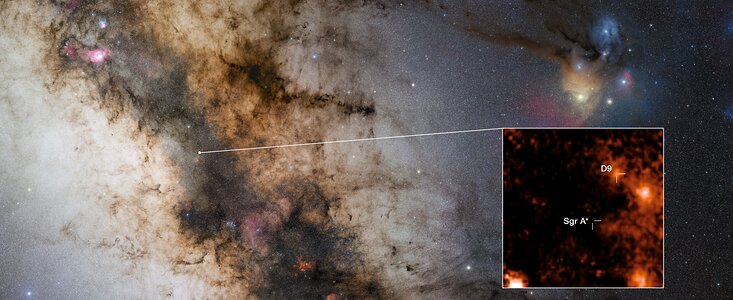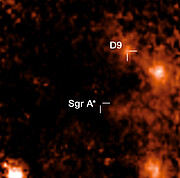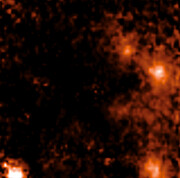Press Release
First ever binary star found near our galaxy’s supermassive black hole
17 December 2024
An international team of researchers has detected a binary star orbiting close to Sagittarius A*, the supermassive black hole at the centre of our galaxy. It is the first time a stellar pair has been found in the vicinity of a supermassive black hole. The discovery, based on data collected by the European Southern Observatory’s Very Large Telescope (ESO’s VLT), helps us understand how stars survive in environments with extreme gravity, and could pave the way for the detection of planets close to Sagittarius A*.
“Black holes are not as destructive as we thought,” says Florian Peißker, a researcher at the University of Cologne, Germany, and lead author of the study published today in Nature Communications. Binary stars, pairs of stars orbiting each other, are very common in the Universe, but they had never before been found near a supermassive black hole, where the intense gravity can make stellar systems unstable.
This new discovery shows that some binaries can briefly thrive, even under destructive conditions. D9, as the newly discovered binary star is called, was detected just in time: it is estimated to be only 2.7 million years old, and the strong gravitational force of the nearby black hole will probably cause it to merge into a single star within just one million years, a very narrow timespan for such a young system.
“This provides only a brief window on cosmic timescales to observe such a binary system — and we succeeded!” explains co-author Emma Bordier, a researcher also at the University of Cologne and a former student at ESO.
For many years, scientists also thought that the extreme environment near a supermassive black hole prevented new stars from forming there. Several young stars found in close proximity to Sagittarius A* have disproved this assumption. The discovery of the young binary star now shows that even stellar pairs have the potential to form in these harsh conditions. “The D9 system shows clear signs of the presence of gas and dust around the stars, which suggests that it could be a very young stellar system that must have formed in the vicinity of the supermassive black hole,” explains co-author Michal Zajaček, a researcher at Masaryk University, Czechia, and the University of Cologne.
The newly discovered binary was found in a dense cluster of stars and other objects orbiting Sagittarius A*, called the S cluster. Most enigmatic in this cluster are the G objects, which behave like stars but look like clouds of gas and dust.
It was during their observations of these mysterious objects that the team found a surprising pattern in D9. The data obtained with the VLT’s ERIS instrument, combined with archival data from the SINFONI instrument, revealed recurring variations in the velocity of the star, indicating D9 was actually two stars orbiting each other. “I thought that my analysis was wrong,” Peißker says, “but the spectroscopic pattern covered about 15 years, and it was clear this detection is indeed the first binary observed in the S cluster.”
The results shed new light on what the mysterious G objects could be. The team proposes that they might actually be a combination of binary stars that have not yet merged and the leftover material from already merged stars.
The precise nature of many of the objects orbiting Sagittarius A*, as well as how they could have formed so close to the supermassive black hole, remain a mystery. But soon, the GRAVITY+ upgrade to the VLT Interferometer and the METIS instrument on ESO’s Extremely Large Telescope (ELT), under construction in Chile, could change this. Both facilities will allow the team to carry out even more detailed observations of the Galactic centre, revealing the nature of known objects and undoubtedly uncovering more binary stars and young systems. “Our discovery lets us speculate about the presence of planets, since these are often formed around young stars. It seems plausible that the detection of planets in the Galactic centre is just a matter of time,” concludes Peißker.
More information
This research was presented in the paper “A binary system in the S cluster close to the supermassive black hole Sagittarius A*” published today in Nature Communications (doi: 10.1038/s41467-024-54748-3).
The team is composed of F. Peißker (Institute of Physics I, University of Cologne, Germany [University of Cologne]), M. Zajaček (Department of Theoretical Physics and Astrophysics, Masaryk University, Brno, Czechia; University of Cologne), L. Labadie (University of Cologne), E. Bordier (University of Cologne), A. Eckart (University of Cologne; Max Planck Institute for Radio Astronomy, Bonn, Germany), M. Melamed (University of Cologne), and V. Karas (Astronomical Institute, Czech Academy of Sciences, Prague, Czechia).
The European Southern Observatory (ESO) enables scientists worldwide to discover the secrets of the Universe for the benefit of all. We design, build and operate world-class observatories on the ground — which astronomers use to tackle exciting questions and spread the fascination of astronomy — and promote international collaboration for astronomy. Established as an intergovernmental organisation in 1962, today ESO is supported by 16 Member States (Austria, Belgium, Czechia, Denmark, France, Finland, Germany, Ireland, Italy, the Netherlands, Poland, Portugal, Spain, Sweden, Switzerland and the United Kingdom), along with the host state of Chile and with Australia as a Strategic Partner. ESO’s headquarters and its visitor centre and planetarium, the ESO Supernova, are located close to Munich in Germany, while the Chilean Atacama Desert, a marvellous place with unique conditions to observe the sky, hosts our telescopes. ESO operates three observing sites: La Silla, Paranal and Chajnantor. At Paranal, ESO operates the Very Large Telescope and its Very Large Telescope Interferometer, as well as survey telescopes such as VISTA. Also at Paranal ESO will host and operate the Cherenkov Telescope Array South, the world’s largest and most sensitive gamma-ray observatory. Together with international partners, ESO operates ALMA on Chajnantor, a facility that observes the skies in the millimetre and submillimetre range. At Cerro Armazones, near Paranal, we are building “the world’s biggest eye on the sky” — ESO’s Extremely Large Telescope. From our offices in Santiago, Chile we support our operations in the country and engage with Chilean partners and society.
Links
- Research paper
- Photos of the VLT
- SFB 1601 group at the University of Cologne
- Find out more about ESO's Extremely Large Telescope on our dedicated website and press kit
- For journalists: subscribe to receive our releases under embargo in your language
- For scientists: got a story? Pitch your research
Contacts
Florian Peißker
Institute of Physics 1, University of Cologne
Cologne, Germany
Tel: +49 221 470 7791
Email: peissker@ph1.uni-koeln.de
Emma Bordier
Institute of Physics 1, University of Cologne
Cologne, Germany
Tel: +49 221 470 3548
Email: bordier@ph1.uni-koeln.de
Michal Zajaček
Department of Theoretical Physics and Astrophysics, Masaryk University
Brno, Czechia
Tel: +420 549 49 8773
Email: zajacek@physics.muni.cz
Bárbara Ferreira
ESO Media Manager
Garching bei München, Germany
Tel: +49 89 3200 6670
Cell: +49 151 241 664 00
Email: press@eso.org
About the Release
| Release No.: | eso2418 |
| Name: | D9 |
| Type: | Milky Way : Star : Grouping : Binary |
| Facility: | Very Large Telescope |
| Instruments: | ERIS, SINFONI |
| Science data: | 2024NatCo..1510608P |
Our use of Cookies
We use cookies that are essential for accessing our websites and using our services. We also use cookies to analyse, measure and improve our websites’ performance, to enable content sharing via social media and to display media content hosted on third-party platforms.
ESO Cookies Policy
The European Organisation for Astronomical Research in the Southern Hemisphere (ESO) is the pre-eminent intergovernmental science and technology organisation in astronomy. It carries out an ambitious programme focused on the design, construction and operation of powerful ground-based observing facilities for astronomy.
This Cookies Policy is intended to provide clarity by outlining the cookies used on the ESO public websites, their functions, the options you have for controlling them, and the ways you can contact us for additional details.
What are cookies?
Cookies are small pieces of data stored on your device by websites you visit. They serve various purposes, such as remembering login credentials and preferences and enhance your browsing experience.
Categories of cookies we use
Essential cookies (always active): These cookies are strictly necessary for the proper functioning of our website. Without these cookies, the website cannot operate correctly, and certain services, such as logging in or accessing secure areas, may not be available; because they are essential for the website’s operation, they cannot be disabled.
Functional Cookies: These cookies enhance your browsing experience by enabling additional features and personalization, such as remembering your preferences and settings. While not strictly necessary for the website to function, they improve usability and convenience; these cookies are only placed if you provide your consent.
Analytics cookies: These cookies collect information about how visitors interact with our website, such as which pages are visited most often and how users navigate the site. This data helps us improve website performance, optimize content, and enhance the user experience; these cookies are only placed if you provide your consent. We use the following analytics cookies.
Matomo Cookies:
This website uses Matomo (formerly Piwik), an open source software which enables the statistical analysis of website visits. Matomo uses cookies (text files) which are saved on your computer and which allow us to analyze how you use our website. The website user information generated by the cookies will only be saved on the servers of our IT Department. We use this information to analyze www.eso.org visits and to prepare reports on website activities. These data will not be disclosed to third parties.
On behalf of ESO, Matomo will use this information for the purpose of evaluating your use of the website, compiling reports on website activity and providing other services relating to website activity and internet usage.
Matomo cookies settings:
Additional Third-party cookies on ESO websites: some of our pages display content from external providers, e.g. YouTube.
Such third-party services are outside of ESO control and may, at any time, change their terms of service, use of cookies, etc.
YouTube: Some videos on the ESO website are embedded from ESO’s official YouTube channel. We have enabled YouTube’s privacy-enhanced mode, meaning that no cookies are set unless the user actively clicks on the video to play it. Additionally, in this mode, YouTube does not store any personally identifiable cookie data for embedded video playbacks. For more details, please refer to YouTube’s embedding videos information page.
Cookies can also be classified based on the following elements.
Regarding the domain, there are:
- First-party cookies, set by the website you are currently visiting. They are stored by the same domain that you are browsing and are used to enhance your experience on that site;
- Third-party cookies, set by a domain other than the one you are currently visiting.
As for their duration, cookies can be:
- Browser-session cookies, which are deleted when the user closes the browser;
- Stored cookies, which stay on the user's device for a predetermined period of time.
How to manage cookies
Cookie settings: You can modify your cookie choices for the ESO webpages at any time by clicking on the link Cookie settings at the bottom of any page.
In your browser: If you wish to delete cookies or instruct your browser to delete or block cookies by default, please visit the help pages of your browser:
Please be aware that if you delete or decline cookies, certain functionalities of our website may be not be available and your browsing experience may be affected.
You can set most browsers to prevent any cookies being placed on your device, but you may then have to manually adjust some preferences every time you visit a site/page. And some services and functionalities may not work properly at all (e.g. profile logging-in, shop check out).
Updates to the ESO Cookies Policy
The ESO Cookies Policy may be subject to future updates, which will be made available on this page.
Additional information
For any queries related to cookies, please contact: pdprATesoDOTorg.
As ESO public webpages are managed by our Department of Communication, your questions will be dealt with the support of the said Department.









